|

by Wal Thornhill
from
Holoscience Website
25 April 2004
.. it may sometimes
be that not to know one thing that is wrong could be more
important than knowing a hundred things that are right.’
Halton Arp, Quasars, Redshifts & Controversies
|
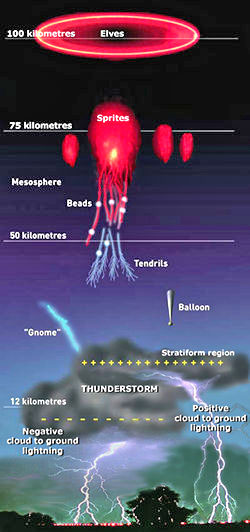
Gnomes, sprites
and elves stretch into space above powerful thunderstorms.
Their fanciful names may reflect the fact that airline
pilots reported them but for many years no one would believe
them. |
The electrical character
of dust devils and tornadoes is rarely mentioned. In fact,
researchers only recently began to examine the electrical nature of
dust devils in an effort to understand what is happening on
Mars.
Mysteries still surround electrical activity in our atmosphere. For
example, the Earth has a vertical electric field, in the order of
100 volts per meter in dry air, whose origin is unknown. And
scientists do not know what causes the most obvious electrical
phenomenon in the atmosphere: lightning. See ’The Balloon
goes up over lightning!’
(image right)
for a discussion of the Electric Universe model of lightning.
|
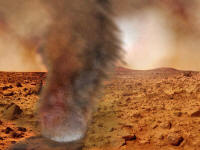
The artist seems
to have intuitively included a glow discharge near the base
of the dust devil.
Credit: University of Michigan
|
However, last week saw
another success for the Electric Universe model. It’s now official
that dust devils on Earth exhibit strong electric fields, in excess
of 4,000 volts per meter. They generate magnetic fields as well. The
researchers who made the discovery added the qualification ’on
Earth’ because the discovery was a surprise. They cannot be certain
that it applies to the dust devils on Mars because their purely
mechanical model did not predict the electrical effects found in
earthly dust devils. However the tentative connection was made and
resulted in the following artist’s impression
(click above left image)
of what an electrified
Martian dust devil might look like.
In July, 1999, I wrote:
’The 5 mile high
dust devils on Mars and the global Martian dust storms are, I
believe, a manifestation of electric discharges on Mars. In the
very low atmospheric pressure lightning would be more like a
diffuse auroral glow. The problem of generating dust storms on
Mars is how to get the particles on the surface to "saltate", or
leave the surface, with such little force in the wind.
Electrostatic forces could easily do the job.’
Several years ago, the
electrical nature of dust devils and tornadoes was suggested in the
Electric Universe Synopsis.
And a fuller explanation of the electromagnetic effects of a
tornadic electric discharge was presented in Sunspot Mysteries
(below image).
There I wrote, ’Make no mistake, the Martian dust devils are
tornadoes that dwarf their earthly counterpart.
|
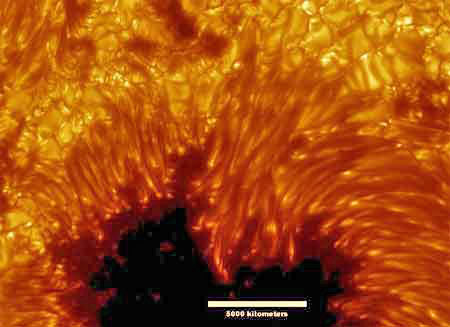
Researchers at the Royal
Swedish Academy of Sciences in Stockholm, led by Goran
Scharmer, discuss the images in the Nov. 14 issue of the
journal Nature:
Team member Dan Kiselman told what he sees in the new views
of the Sun: "A dark-cored filament looks like a glowing
snake with a dark stripe painted along its back," Kiselman
said. "The 'head' of the snake is often a complicated
feature where the stripe splits up among many bright
points."
The pictures were taken with academy's recently installed
solar telescope at La Palma, in the Canary Islands off the
coast of Africa. Movies made by putting sequential images
together show that that the dark cores of the filaments are
long-lived and possibly more stable than the brighter
portions. The scientists also identified canal-like
structures in the so-called penumbra of sunspots that "could
also be described as a pattern of cracks," Kiselman said.
The penumbra straddles a sunspots dark core and brighter
regions elsewhere on the solar surface. "Whatever metaphors
we use for these features, one should remember that
everything is just glowing gas." |
It shows that clouds
are not required to generate them. They are an atmospheric electric
discharge phenomenon.’
More recently I suggested that the Mars Exploration Rover, Spirit,
which landed in a dust devil scarred area, suffered electrical
interference severe enough to cause computer problems.
Now in a report from Astrobiology Magazine, Dr. William Farrell of
NASA’s Goddard Space Flight Center says,
’Dust devils are
common on Mars, and NASA is interested in them as well as other
phenomena as a possible nuisance or hazard to future human
explorers.’
’If martian dust
devils are highly electrified, as our research suggests, they
might give rise to increased discharging or arcing in the
low-pressure martian atmosphere, increased dust adhesion to
space suits and equipment, and interference with radio
communications.’
Farrell is the lead
author of the paper about this research published in the Journal of
Geophysical Research.
"Two ingredients,
present on both Earth and Mars, are necessary for a
dust devil
to form: rising air and a source of rotation," said Dr. Nilton
Renno of the University of Michigan, Ann Arbor, Mich., a member
of the research team and expert in the fluid dynamics of dust
devils. "Wind shear, such as a change in wind direction and
speed with altitude, is the source for rotation. Stronger
updrafts have the potential to produce stronger dust devils, and
larger wind shear produces larger dust devils," Renno said.
Comment: In the
words of Halton Arp, ’not to know one thing that is wrong could be
more important than knowing a hundred things that are right.’ In
this case it is the confusion of cause and effect. It is simply
assumed that the Earth and its environment in space is electrically
neutral. Therefore some energy is required to cause charge to
separate and produce the strong electric field in the dust devil.
The only energy available is solar radiation and the movement of air
(fluid dynamics). However, in an electrified universe charge is
already separated on the macroscopic scale and the movement of air
in a dust devil is an effect of charge recombination, not a cause of
charge separation.
Dust particles
become electrified in dust devils, when they rub against each
other as they are carried by the winds, transferring positive
and negative electric charge the same way you build up static
electricity if you shuffle across a carpet. Scientists thought
there would not be a high-voltage, large-scale electric field in
dust devils, because negatively charged particles would be
evenly mixed with positively charged particles, so the overall
electric charge in the dust devil would be in balance.
Comment: It is
clear from laboratory experiments that different size dust grains
can charge to opposite polarities upon collision. However, the
electric force between oppositely charged grains would tend to
prevent their separation. That is what scientists expected and it
explains their surprise when the opposite was found. But it may not
be so surprising if we stop treating a dust devil as a fluid
dynamics problem and consider it instead as weakly ionized plasma
subject to the Earth’s vertical clear-air electric field. In such
circumstances the electric field may be strongest (and the electric
field reversed) at the base of the dust devil due to the formation
of a plasma ’double layer’ or ’virtual cathode.’
However, the team’s
observations indicate smaller particles become negatively
charged, while larger particles become positively charged.
Dust
devil winds carry the small, negatively charged particles high
into the air, while the heavier, positively charged particles
remain near the base of the dust devil. This separation of
charges produces the large-scale electric field, like the
positive and negative terminals on a battery. Since the
electrified particles are in motion, and a magnetic field is
just the result of moving electric charges, the dust devil also
generates a magnetic field.
Comment: The
earth and all other bodies in the universe are not isolated and
electrically inert. They are intimately connected to and influenced
by the Electric Universe. This means that dust devils are not a
local event, but are driven like motors by a cosmic current.
Dust
devils and storm clouds do not act as ’batteries’ or ’dynamos’ to
provide power to a global atmospheric circuit. As for the magnetic
effects of a tornado or dust devil, they will be very strong because
the charges are moving at meters per second instead of centimeters
per hour, as happens in a current-carrying wire.
If martian dust
grains have a variety of sizes and compositions, dust devils on
Mars should become electrified the same way as their particles
rub against each other, according to the team. Martian dust
storms, which can cover the entire planet, are also expected to
be strong generators of electric fields. The team hopes to
measure a large dust storm on Earth and have instruments to
detect atmospheric electric and magnetic fields on future Mars landers.
Comment: In the
electrical model of the solar system, all planets must contrive to
supply electrons to the positively charged Sun. Mercury probably
does it in a similar way to our Moon, through photoelectric and
cold-cathode emission. Occasionally the emission may be strong
enough at certain ’hot spots’ to cause the anomalous glows seen on
the Moon. The next planet from the Sun,
Venus, has an ionosphere
entwined in current ’ropes’ from the solar wind. It causes powerful
’super bolts’ of lightning to fly between the planet’s ionosphere
and the surface. It seems the electric field at Venus’ hot surface
is so strong that above a certain altitude the atmosphere hugging
the surface glows with a surface discharge known as St. Elmo’s fire.
Being dense plasma it reflected the radar signal from the Magellan
Orbiter as if the mountains of Venus were plated with metal, much to
the puzzlement of planetary scientists.
On Earth we have water clouds to charge up between the ionosphere
and the Earth and spare us the super bolts of Venus. Although there
are rare reports of ’bolts from the blue,’ the Earth contrives to
discharge in two stages, by lightning from ground to cloud and by
glowing jets from the cloud to the ionosphere. The latter stage has
only recently been recognized and the flashes given whimsical names
like ’sprites,’ ’elves’ and ’gnomes,’ which probably reflects the
scientists’ disbelief before they were finally acknowledged. On rare
occasions, a powerful lightning bolt strikes directly from the cloud
tops to Earth. Such super bolts rip electrons violently from the
earth and may form small-scale furrows like those seen on all other
solid bodies in the solar system.
|
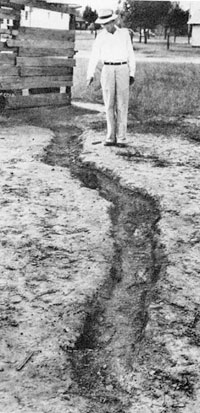 |
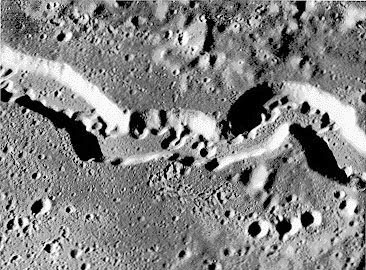
Above: This is a section of a prominent lunar
rille, Schr’s Valley, which also shows the tortuous path
of the lightning along the floor of the wider trench
.
Left:
This 40 foot rille was torn out by lightning. The more
tortuous path of the narrow lightning stroke can be seen
as a groove in the bottom of the trench. Credit:
National Geographic, June 1950
.
|
Usually the cloud to
ground discharge takes the form of the multiple sparks we call
lightning. However, in some parts of the world the lightning
switches to the slower discharge of the tornado. Then, instead of
the electric charge rushing directly between the ground and the
cloud along a thin lightning channel, it is constrained by powerful
electromagnetic forces to rotate in a long, thin cylinder or vortex.
Measurement of the magnetic field and earth current near touchdown
of a tornado shows that it is electrically equivalent to several
hundred storm cells. It is this concentrated electrical power in the
central vortex that creates damage far in excess of that possible
for a simple wind vortex. It also explains the burnt surfaces and
objects sometimes found after the passage of a tornado.
The thin dry atmosphere of Mars and the large temperature gradient
near the surface is certainly conducive to the formation of dust
devils. However, like the other planets, Mars has to supply
electrons to the solar discharge. The high electron density above
Mars was remarked upon when the first orbiting spacecraft arrived
there. Images from Mars landers of a dust laden pink sky were also a
surprise. Scientists expected a deep blue-black sky because the
atmosphere is about a hundred times thinner than ours and less able
to hold dust suspended. In the thin, practically cloudless air of
Mars, the dust devils provide the best means of moving electrons
from the surface toward the Martian ionosphere. The dust particles,
becoming charged, would be suspended in Mars atmospheric electric
field to give the pink sky. In other words, Martian dust devils are
more akin to tornadoes. Towering up to 8 kilometers into the sky
their destructive capability at the surface would be far more
powerful than that of a simple spinning wind in Mars’ thin air.
When these Martian tornadoes pass over the surface of
Mars, they
often leave dark, criss-crossing streaks on the land. It is simply
assumed that the wind removes bright dust from the terrain,
revealing a darker surface underneath. It is possible however, that
electrical damage to the surface, and therefore erosion, is being
caused by the Martian tornadoes. They certainly pose a much greater
risk to landing craft and future visiting astronauts than scientists
expect.
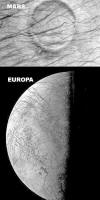 Meanwhile
there is another example of an electrically damaged body whose
surface patterns bear a strong resemblance to those formed by the
electric tornadoes on Mars. It is Jupiter’s moon, Europa. Meanwhile
there is another example of an electrically damaged body whose
surface patterns bear a strong resemblance to those formed by the
electric tornadoes on Mars. It is Jupiter’s moon, Europa.
Traveling discharges created giant furrows on Europa reflecting the
great strength of those wandering arcs compared to the diffuse
discharges on Mars today. The furrows on Europa are not cracks in
the ice. They are instead a frozen record of the catastrophic power
of Jupiter’s thunderbolt, when unleashed by that electrical
powerhouse of a planet.
The Electric Universe model provides a unifying concept for
understanding the solar system by simply accepting the overwhelming
evidence for the primary role of electricity and the electric force
in the mechanism of the cosmos. Future historians will find the
science of the 20th century extraordinary for its insistence on a
cosmology based on pre-industrial-revolution thinking. Electricity
was a mystery then and remains so into the 21st century for
astronomers and geologists. Once again, to not know this simple fact
is more important than all things they do know.
|






